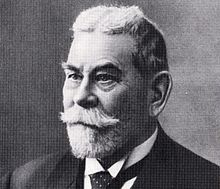A. Kirsten
The shipping company A. Kirsten in Hamburg was the second oldest German shipping company . Only Sloman is older.
history
In 1801 John Fontenay (1770–1835) began working as a ship broker in Hamburg. In 1802 he married the wealthy widow Anna Catharina Kirsten, b. Ballheimer. The widow of a butcher brought four underage children into the marriage. In 1827 John Fontenay's stepson Heinrich Friedrich Kirsten took over the brokerage firm Fontenay & Hesleden. After Fontenay's death in 1835, he renamed the company HF Kirsten. After HF Kirsten's death (1866), Adolph Kirsten (1839–1915) took over his father's company and founded the ship brokerage company A. Kirsten on the same day. In 1878 Adolph Kirsten founded his own shipping company under the name A. Kirsten and took his brother Robert into the company.
The shipping company's office flag was created from the racing stand that Heinrich Friedrich Kirsten's sons used as boys in regattas on the Alster . On September 24, 1854, a Kirsten boat started under this pennant for the first time in an Alster regatta. Since then, the red and white racing flag has appeared in all regattas where Kirsten boats have sailed. The office flag was similar to the answer from the flag alphabet : the tapering pennant with vertical alternating red and white stripes, had brought the name mixed bacon (fat and lean) in seafaring circles . The chimney color was black. In the family, the flag was also called Badebüx. Since Adolph Kirsten was a great fan of Shakespeare , almost all ships were given names from the works of the English poet from the start.
Kirsten began liner services to Great Britain in 1879 and then tried lines to the west coast of South America ( Hamburg-Pacific Steamship Line , 1886–1898) and to India ( Hamburg-Calcutta Line AG , 1888–1897). When the First World War broke out , the shipping company owned 29 ships with almost 30,000 GRT . Of these, only eight ships remained after the war. The original line of business as an agency helped rebuild the shipping business. At first it was limited to the traditional shipping area Hamburg- London , later Kirsten expanded his shipping areas from London to the Rhine ports. This was followed by a trampoline trip to the Mediterranean and northwest Africa. The Second World War also ended with the loss of almost the entire fleet with the exception of the 1908-built 1047 BRT steamer Jessica and the cargo steamer Ophelia , which continued to operate as lock breaker 172 with the GMSA until the late 1940s .
The shipping company's traditionally good relations with England made it possible to resume services in the London, Rotterdam and up the Rhine area in 1949. The shipping company broke new ground with the establishment of the Hamburg-Chicago Line , which it successfully operated jointly with the Sartori & Berger shipping company from the early 1950s . For the new buildings commissioned for this purpose, the maximum length of 79 meters had to be strictly adhered to, which was specified by the 29 locks on the St. Lawrence Seaway up to the Great Lakes . The services on the Rhine were extended from London to Basel . The Kirstenschiffe caught the eye because they were the only ones equipped with real lifeboats .
The three 5000-tonne trucks (total length 106 meters), Virgilia , Valeria and Volumnia , which were delivered by the Stülckenwerft in 1957/58 , were built especially for the wintry North Atlantic and the Great Lakes voyage , but they were still able to handle the future in several ways Needs planned over. With one exception (which, however , was immediately resold from Helgen ), they were the largest ships that A. Kirsten had ever commissioned. Nevertheless, due to their now insufficient cargo capacity , they were no longer competitive due to the St. Lawrence Seaway, which had been generously developed since 1959 and which has since allowed the Great Lakes to be sailed with large ocean-going vessels , and in later years they were only able to offer unsatisfactory rates for a few Traveling in changing areas or being employed in time charter . In addition to the structural change in the UK voyage at the same time, they may have contributed to the fact that the A. Kirsten shipping company had to file for bankruptcy in 1975 after 148 years of existence .
Family graves
After John Fontenay's death in 1835, his widow acquired a crypt on the burial ground of St. Michaeliskirche in front of the Dammtor. It was just a few minutes' walk from the family headquarters and outside the city walls. These burial places near the city were closed for burials in 1879. The family then bought a grave in the Ohlsdorf cemetery (grid square Z 11). The bones of John Fontenay have only been lying here since 1924. The middle section of the original tomb and all of the family's remains were moved from the St. Michaelis burial site to Ohlsdorf. An engraving with the name Fontenays on a narrow marble slab on the family grave reminds us of the famous Hamburg merchant of American origin.
In addition, at grid square T 21 (southeast of Chapel 2, north of Kapellenstrasse ) the family grave “A. Kirsten ”including pillow stone for Adolph Kirsten .
literature
- Mathias Eberenz, Dieter Gartmann, Harald A. Kirsten: John Fontenay - Hamburg ship broker and businessman - founder of the John Fontenay's Testament Foundation . Ed .: Foundation "John Fontenay's Testament". 1st edition. Medien-Verlag Schubert, Hamburg 2010, ISBN 978-3-937843-24-7 .
- Maria Möring: A. Kirsten, Hamburg . Ed .: Wirtschaftsgeschichtliche Forschungsstelle e. V. Christians, Hamburg 1952, OCLC 257901972 .
Web links
- Collection of memorabilia about the ships of the shipping company A. Kirsten
- The Kirsten villas on Bellevue




